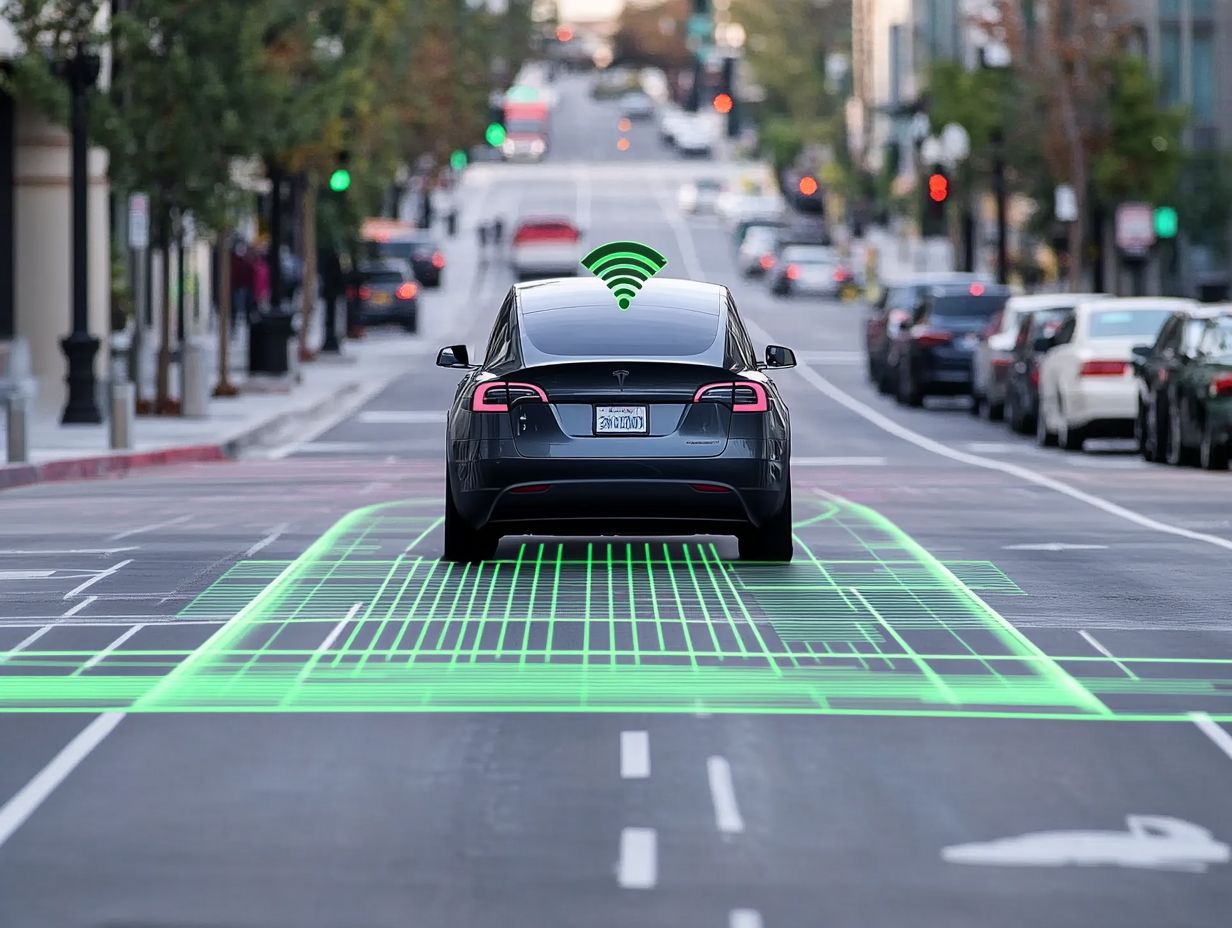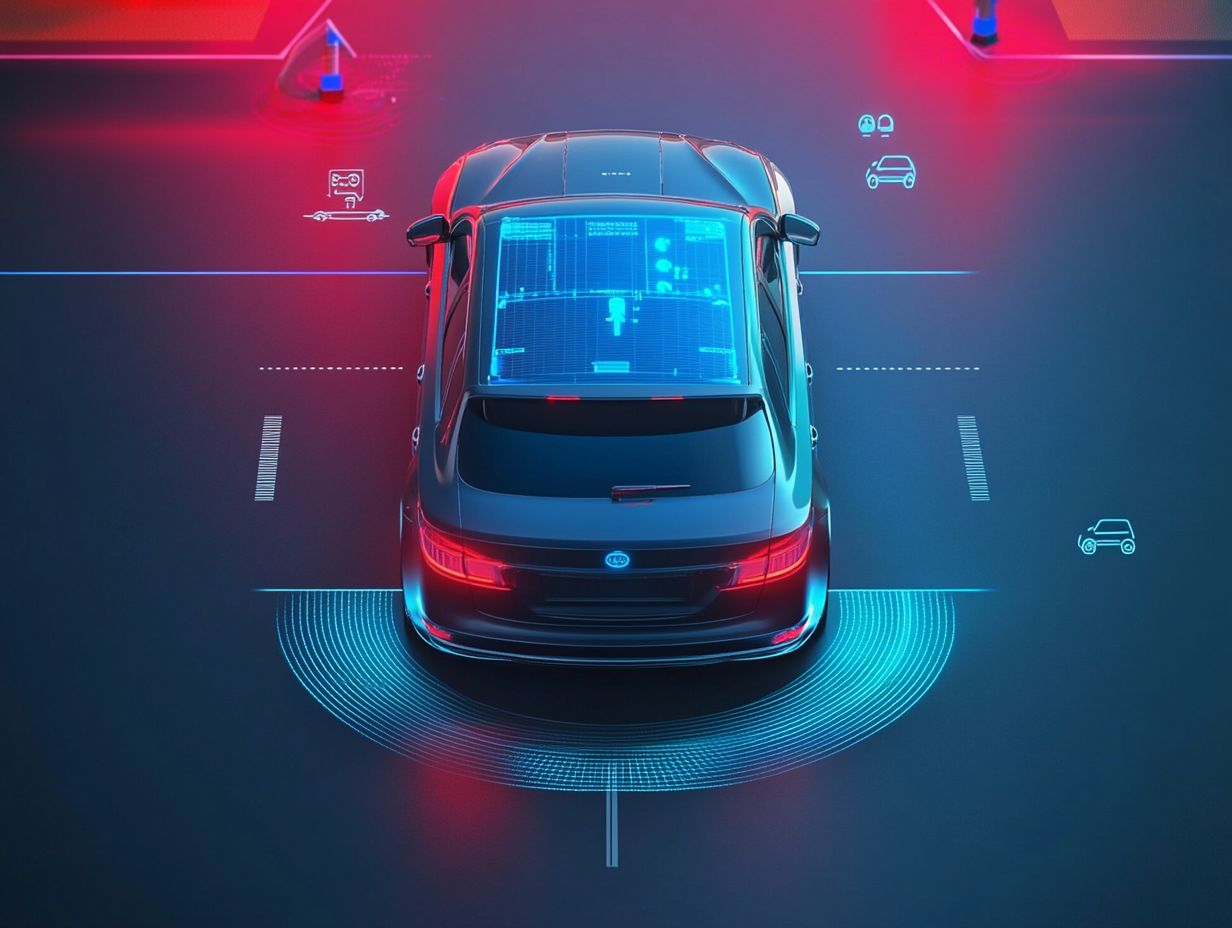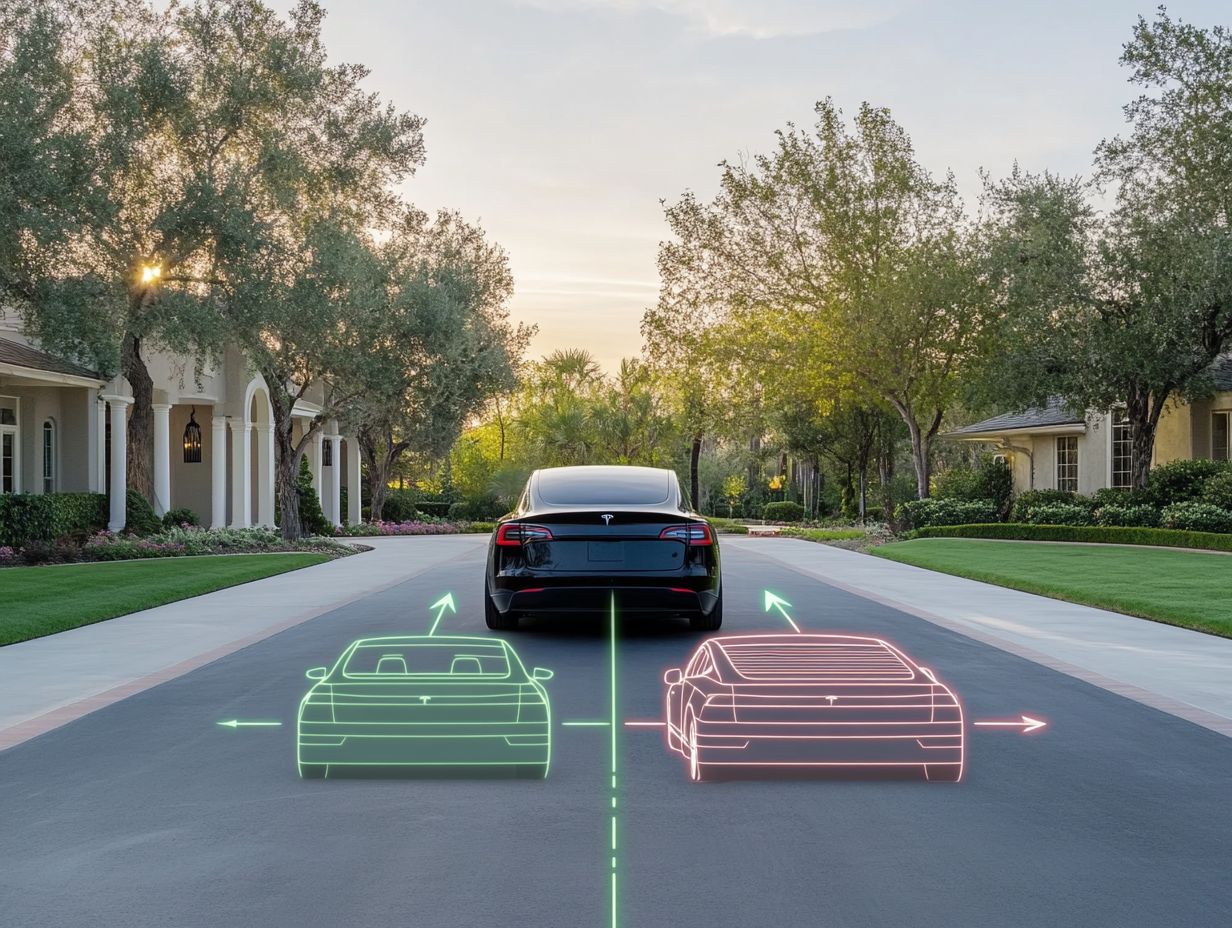Comparison of Autonomous Driving Features
Self-driving technology is revolutionizing your perspective on transportation, providing an exciting look into a future where cars seamlessly navigate the roads with minimal human input.
This article delves into the complexities of autonomous driving, breaking down the various levels of autonomy from fundamental features like adaptive cruise control, which helps maintain a safe distance from the vehicle in front, to sophisticated systems such as urban pilots.
Each level showcases unique functionalities and capabilities. This encourages you to grasp how these technologies operate and their potential influence on your daily life.
Join us on a thrilling journey as we compare features across different levels of autonomous driving, uncovering the thrilling possibilities that await you.
Contents
- Key Takeaways:
- Levels of Autonomy
- Features of Level 2 Autonomous Driving
- Features of Level 3 Autonomous Driving
- Features of Level 4 Autonomous Driving
- Frequently Asked Questions
- What does comparing autonomous driving features mean?
- What are some common features compared in autonomous driving?
- How can I compare the safety features of autonomous driving systems?
- Are there differences in the mapping and localization capabilities of autonomous driving systems?
- What factors should I consider when comparing vehicle control systems of autonomous driving?
- Is there a standard for comparing autonomous driving features?
Key Takeaways:

- Level 2 autonomous driving features help reduce driver fatigue and improve highway safety.
- Level 3 autonomous driving features enable hands-free driving under specific conditions.
- Level 4 autonomous driving features allow for near-full automation in urban environments.
Overview of Self-Driving Technology
Self-driving technology has truly transformed the automotive landscape, setting the stage for advanced driving systems that promise to elevate safety and efficiency on the roads.
With industry leaders like Tesla, Audi, and Toyota at the forefront, features such as adaptive cruise control, lane centering, and full self-driving capabilities are becoming more commonplace.
This technology does more than optimize vehicle performance; it also integrates advanced driver assistance systems that monitor your attentiveness, ensuring your safety on the road.
As you delve into the evolution of self-driving technology, you’ll uncover its profound implications for the future of driving.
The rise of autonomous vehicles has captured the attention of both consumers and regulators alike, reflecting a pivotal shift in our perception of transportation.
Key players like Tesla are rolling out over-the-air updates to enhance software functionality, while Audi is perfecting its sophisticated sensor technologies, enabling vehicles to effortlessly navigate complex environments.
The incorporation of safety features such as automatic emergency braking and pedestrian detection is becoming standard, ultimately creating a safer driving experience for everyone.
As these innovations continue to progress, expect collaborative efforts between tech companies and automakers to shape regulatory frameworks. This will facilitate a seamless transition toward the widespread adoption of fully autonomous vehicles.
Levels of Autonomy
As you embark on the journey toward fully autonomous vehicles, it s essential to familiarize yourself with the various levels of autonomy defined by the Society of Automotive Engineers (SAE).
These levels span from Level 0, where no automation is present, to Level 5, where vehicles can seamlessly operate without any human intervention.
Grasping these levels is vital for assessing advancements in driving technology and their implications for driver safety and supervision.
In this section, you ll delve into the characteristics of each level and discover how they collectively contribute to the evolution of automated driving solutions.
Stay informed about the latest advancements in driving technology!
Understanding the Different Levels
Understanding the various levels of autonomy is crucial for grasping how driving technology is progressing toward full automation.
As you delve into the conversation surrounding autonomous vehicles, it’s essential to recognize that Level 0 represents a scenario in which the human driver maintains complete control and enjoys the traditional driving experience without any assistance.
In contrast, Level 1 introduces systems that lend a helping hand to the driver, such as adaptive cruise control, which keeps a set speed and maintains a safe distance from other vehicles. Level 2 incorporates lane-keeping assist to provide even greater support on the road.
As you explore Levels 3 and 4, vehicles like the Tesla Model 3 and Google’s Waymo self-driving cars showcase significant advancements. These cars can manage most driving tasks under specific conditions but still require you to remain alert and ready to intervene when necessary.
The aspiration for Level 5 technology comes to life in the futuristic concepts developed by companies like Cruise, striving for fully autonomous vehicles that demand no human oversight whatsoever. This is an exciting leap forward in road safety and convenience, transforming how we think about driving.
Features of Level 2 Autonomous Driving
Level 2 autonomy refers to a technology where vehicles can handle certain driving tasks, yet it still demands your engagement and readiness to take control at any moment.
Features in this level of automation include adaptive cruise control, which adjusts your speed based on traffic conditions, and lane-keeping assist, which helps your vehicle stay within its lane. Systems like Tesla Autopilot and Mobileye lead the charge in implementing these advanced technologies.
Understanding these features is crucial for evaluating their influence on your attentiveness as a driver and the overall safety on the road.
Adaptive Cruise Control
Adaptive cruise control is a remarkable innovation in modern driving technology. It enables your vehicle to automatically adjust its speed to maintain a safe distance from the car in front of you. By using sensors and cameras, this system enhances vehicle performance and integrates collision warnings, fostering a safer driving experience.
It’s essential to remember that staying attentive is key; this feature doesn’t eliminate the need for your supervision. This technology, available in luxury brands like Tesla, BMW, and Mercedes-Benz, employs radar and sophisticated algorithms to monitor the speed and distance of vehicles ahead, making real-time adjustments as needed.
For example, if the car in front slows down, adaptive cruise control smoothly reduces your speed without you needing to lift a finger. This adds convenience during those long stretches on the road.
However, as part of Level 2 autonomy, you must remain engaged and prepared to take control if the situation calls for it. Various manufacturers showcase how this feature significantly reduces the likelihood of rear-end collisions and alleviates driver fatigue, enhancing overall safety while promoting a more collaborative environment on the road.
Lane Keeping Assist

Lane keeping assist is an essential feature of Level 2 autonomous driving technology that helps you maintain your vehicle’s position within its lane. By providing corrective steering input when it detects unintended lane departures, this system plays a crucial role in enhancing road safety.
However, it s important for you to remain vigilant, as effectively using lane keeping assist still requires your active supervision and intervention.
This technology operates by using cameras and sensors that continuously monitor lane markings on the road. If your vehicle begins to drift without signaling, the system gently nudges the steering wheel, guiding you back to the center of the lane and reducing the risk of accidents caused by drifting.
Many modern vehicles, such as the Tesla Model 3, Honda Accord, and Ford Explorer, come equipped with this innovative capability, enriching your driving experience while prioritizing safety. Despite these advancements, it s vital for you to stay alert and ready to take control. Relying solely on lane keeping assist can lead to complacency and unsafe driving behavior.
Stay engaged for your safety!
Features of Level 3 Autonomous Driving
Level 3 autonomy is a significant advancement in automated driving. This technology allows vehicles to handle most driving tasks under certain conditions, particularly during highway travel.
This level features innovations like highway pilot, enabling the vehicle to navigate and make decisions with minimal input from you. It s crucial to stay alert, as driver supervision is still required.
You must be ready to take control if the vehicle encounters situations beyond its operational capabilities. This reality is underscored by tests such as the emergency stop test, which ensures the vehicle can stop safely in emergencies.
Highway Pilot
The highway pilot represents a remarkable leap in Level 3 autonomy. It allows you to let your vehicle manage complex driving tasks on highways with minimal intervention. This feature optimizes your vehicle’s performance during long-distance travel.
By intelligently navigating traffic patterns and adjusting speed based on real-time data, the highway pilot system enhances fuel efficiency and reduces your fatigue. Imagine embarking on a cross-country trip where this technology can facilitate a smoother ride by seamlessly merging and changing lanes.
However, you must stay alert and ready to disengage the system if unexpected situations arise, such as sudden road construction or adverse weather conditions. This combination of autonomy and human oversight epitomizes the evolving landscape of transportation technology, emphasizing safety and adaptability.
Conditional Automation
Conditional automation in Level 3 autonomy enables you to allow the vehicle to handle driving tasks under specific conditions. However, you must remain attentive and ready to jump back in at any moment.
This level comes equipped with advanced safety features like emergency braking. It demands thorough evaluation of systems to ensure they perform reliably across various scenarios.
While you may experience a brief reprieve from your usual driving duties, it s vital to stay prepared to take control should the system face unexpected obstacles or limitations. For instance, vehicles like the Audi A8 and the Mercedes-Benz S-Class showcase this technology.
These advancements enhance your driving comfort and underscore the crucial need for your ongoing vigilance, ensuring safety even when automated systems take the wheel.
Features of Level 4 Autonomous Driving
Level 4 autonomy is a remarkable advancement in driving technology. It allows vehicles to operate independently within designated environments without any need for driver intervention.
This level introduces sophisticated features like an urban pilot, which facilitates automated navigation through bustling city streets. It also includes features that allow the car to drive itself under certain conditions, improving efficiency.
Urban Pilot
Urban pilot technology signifies a leap into Level 4 autonomy. It enables your vehicle to navigate complex urban landscapes without any human intervention.
This remarkable feature enhances vehicle performance by integrating advanced sensors and AI systems. This allows for effortless movement through traffic, pedestrian zones, and ever-changing road conditions.
These systems are designed to interpret real-time data, recognizing traffic signals and detecting obstacles. This ensures your safe passage even amidst the hustle and bustle of city life.
Manufacturers like Mercedes-Benz and Waymo are at the forefront of this innovation. As urban pilot capabilities continue to evolve, you can expect reductions in congestion and increases in safety.
This autonomy contributes to decreased emissions, making a significant impact on the sustainability of urban transport systems.
High Automation

High automation within Level 4 autonomy enables your vehicle to handle all driving functions in specific scenarios. This significantly enhances both your safety and convenience. This level of automation includes features like emergency stop tests, which ensure reliability and dependability across various driving conditions.
By integrating advanced sensors, artificial intelligence, and real-time data analysis, your vehicle can navigate complex urban environments with minimal human intervention. Certain models from Tesla and Waymo exemplify this remarkable capability, seamlessly blending with existing technologies such as adaptive cruise control and lane-keeping assist.
This level of automation diminishes the risk of human error, one of the leading causes of accidents. It also allows you to focus on other activities while maintaining safe travel. The continuous learning algorithms in these systems enhance their performance. They adapt to a broad spectrum of driving conditions, ultimately contributing to overall transportation safety.
Frequently Asked Questions
What does comparing autonomous driving features mean?
Comparing autonomous driving features refers to analyzing and evaluating the different capabilities and functionalities of self-driving vehicles offered by various manufacturers.
What are some common features compared in autonomous driving?
Common features in autonomous driving include sensor technology, vehicle control systems, mapping and localization, and safety mechanisms.
How can I compare the safety features of autonomous driving systems?
You can compare the safety features of autonomous driving systems by looking at the number of sensors used, the types of sensors, and the algorithms employed for collision avoidance and emergency braking.
Are there differences in the mapping and localization capabilities of autonomous driving systems?
Yes! Different companies use various mapping techniques and technologies, such as lidar (a technology that uses lasers to measure distances), cameras, or radar. These can affect the accuracy and reliability of the vehicle’s localization abilities.
What factors should I consider when comparing vehicle control systems of autonomous driving?
When comparing vehicle control systems, consider factors like the level of automation, response time, and adaptability to different road and weather conditions.
Is there a standard for comparing autonomous driving features?
Currently, there is no industry-wide standard for comparing autonomous driving features. However, organizations like the National Highway Traffic Safety Administration (NHTSA) and the Society of Automotive Engineers (SAE) have established guidelines and classifications for autonomous driving technology.





